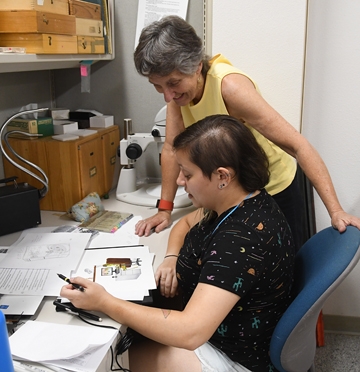
So wrote an undergraduate student in one of Lynn Kimsey's entomology classes at the University of California, Davis.
The student meant "sperm."
But it came out "perm."
That's just one of the sentences that Kimsey, a 29-year Department of Entomology and Nematology faculty member and director of the Bohart Museum of Entomology, has collected through the years.
Now some of the prized collection has found its way into an innovative and fun calendar published by the Bohart Museum of Entomology and illustrated by talented graphic artist Karissa Merritt, a fourth-year entomology student at UC Davis.
For the bee sentence, Merritt depicted a queen bee in a salon admiring herself after receiving a permanent, the royal treatment. The accommodating drone (note the wrap-around eyes!) approves.
Other prized sentences include:
- “The swarmers are attracted to lights and tend to expose themselves in the evenings.” (see art below)
- "The infected fleas can harbor rats, ground squirrels, rabbits, and occasionally, even house cats.” (see art below)
Merritt, a two-year Bohart associate, illustrated the entire calendar, drawing upon her creativity, humor and imagination. “Karissa is a gifted graphic artist,” Kimsey said.
That she is!
The calendar, published by Tara Baumann & Associates of Vacaville, is a project of the non-profit Bohart Museum Society. The calendar sells for $12 at the Bohart Museum, located in Room 1124 of the Academic Surge Building on Crocker Lane. Those who contribute $50 or more to the Bohart Museum Society will receive a calendar with their donation. All proceeds are earmarked for research, education and outreach projects.
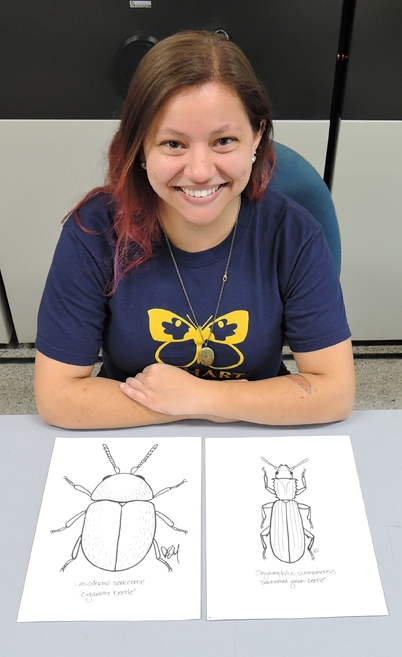
“One aspect of teaching this course is the writing requirement," she explained. "Students at UC Davis are required to take a number of units in general education, science and writing. My course fulfills two of those requirements, which means that I have to require—and grade—student term papers as part of their assignments. I can say definitely that student writing abilities have not improved over the years. So, to alleviate the pain of grading these works of art, I started collecting particularly silly or otherwise awesome sentences from their papers.”
Lynn Kimsey, who holds a doctorate in entomology from UC Davis, joined the faculty in 1989. She specializes in bees, wasps and insect diversity.
Karissa Merritt not only enjoys drawing insects but teaching others how to do so. Last January, the Bohart Museum featured her as an “artist in residence” at its open house on insects and art. She offered tips on how to draw insects and took requests from youths. “It was touching to see how something like mundane doodling could bring smiles to kids' faces,” she said. “In fact, many ended up going home with original art work!"
Merritt says insects have always fascinated her. "I've always loved insects and the natural world but I didn't realize entomology was a viable career choice until one of my friends starting working in the Essig Museum of Entomology at UC Berkeley," she said. She credits her attendance at the College of the Canyons in Santa Clarita, with sparking “a strong interest in pollinators and a particular interest in bees and how I can contribute to their future."
What especially fascinates her the most about insects? “How alien their biology and morphology as compared to vertebrates,” Merritt said. “But working in the Bohart, I find many specimens that just amaze me with their beauty. Insects are just so diverse and it's amazing what nature produces!"
Merritt's favorite insect order is Hymenoptera, which includes bees, ants and wasps. “But I like all insects,” she acknowledged. She learned beekeeping when she volunteered in the lab of Extension apiculturist Elina Lastro Niño at the Harry H. Laidlaw Jr. Honey Bee Research Facility, UC Davis.
Merritt is also an alumnus of “Bug Boot Camp,' a five-week insect taxonomy and field ecology course taught by Phil Ward, UC Davis professor of entomology and held at the Sagehen Creek Field Station, in California's northern Sierra Nevada. That course enabled her to sharpen her taxonomy skills.
The Bohart Museum houses a global collection of nearly eight million insect specimens, and is the home of the seventh largest insect collection in North America and the California Insect Survey, a storehouse of insect biodiversity. The facility also includes a gift shop and a live "petting zoo" of Madagascar hissing cockroaches, walking sticks, and tarantulas.
The Bohart Museum is open to the public (free admission) from 9 a.m. to noon and 1 to 5 p.m. Mondays through Thursdays. More information on the Bohart Museum is available on the website at http://bohart.ucdavis.edu or by contacting (530) 752-0493 or emailing bmuseum@ucdavis.edu.
Attached Images:
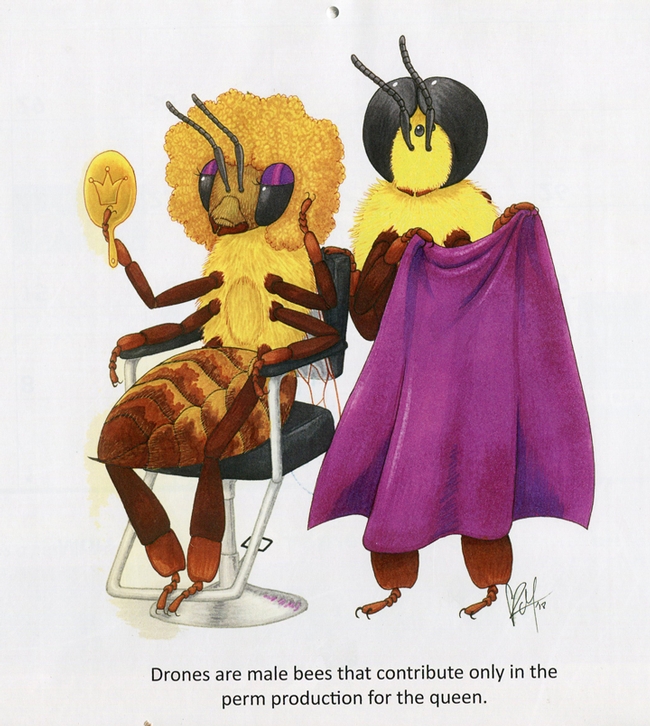
A UC Davis student wrote: "Drones are male bees that contribute only in the perm production for the queen." That inspired Karissa Merritt to create this for the newly published Bohart Museum of Entomology calendar, now available for purchase.
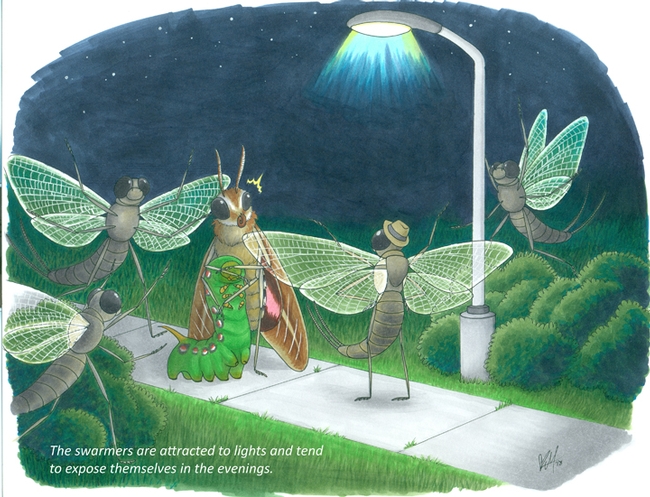
“The swarmers are attracted to lights and tend to expose themselves in the evenings," a UC Davis student wrote about mayflies. The result: this illustration by Karissa Merritt for the Bohart Museum of Entomology's innovative calendar.
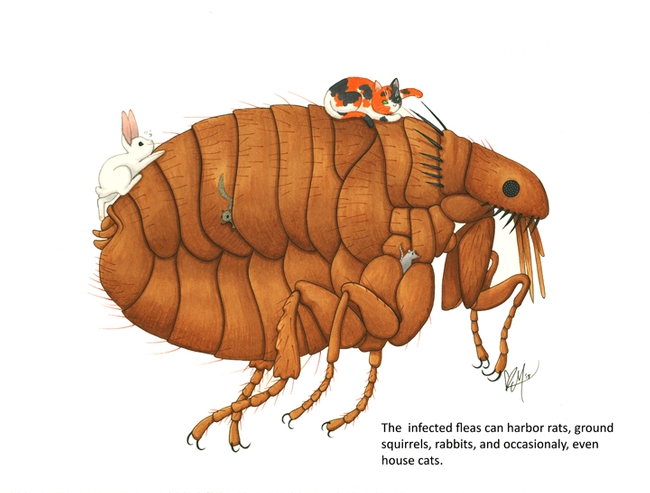
"The infected fleas can harbor rats, ground squirrels, rabbits, and occasionally, even house cats," wrote a UC Davis student. The result: this illustration by Karissa Merritt for the Bohart Museum of Entomology calendar.
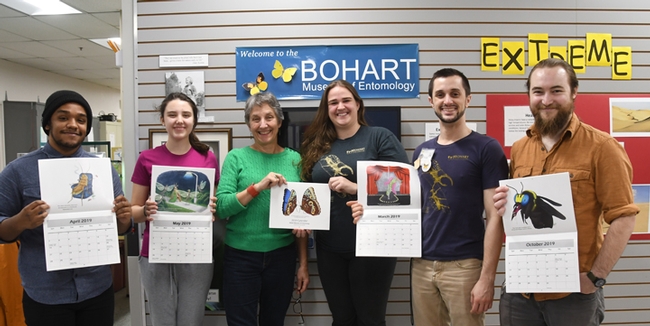
Displaying the innovative Bohart Museum calendars are museum associates and the director. From left are UC Davis entomology student Abram Estrada; intern Sophia Lonchar of The Met High School, Sacramento; Bohart Museum director Lynn Kimsey; UC Davis entomology student Wade Spencer, and Bohart scientist Brennen Dyer, a recent entomology graduate. (Photo by Kathy Keatley Garvey)